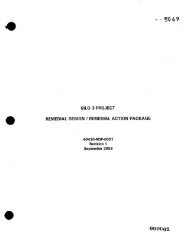closure project manager - Document Request - U.S. Department of ...
closure project manager - Document Request - U.S. Department of ...
closure project manager - Document Request - U.S. Department of ...
You also want an ePaper? Increase the reach of your titles
YUMPU automatically turns print PDFs into web optimized ePapers that Google loves.
area, or the Building 996 waste storage area. The facility fire is assumed to initially involve<br />
combustible materials located in close proximity to stored waste containers. The fire causes<br />
heating <strong>of</strong> the waste containers and their contents, pyrolyzing <strong>of</strong> the container contents, and<br />
subsequent venting <strong>of</strong> container gases containing radioactive material through failed container<br />
lid seals. This size fue is postulated to activate the automatic sprinkler system in the north waste<br />
storage areas (excluding Building 996). Activation <strong>of</strong> the automatic sprinkler system may or<br />
may not occur in the south waste storage areas due to ceiling height; however, the automatic<br />
sDrinkIer svstem is credited as a prewentivelmitiaative feature. The consequences <strong>of</strong> this event<br />
are reduced if the automatic sprinkler system activates (postulated that the fire will impact<br />
three 55-gallon waste containers if the automatic sprinkler system activates).<br />
The postulated facility fire involving six 55-gallon TRU waste drums in the Building 99 1<br />
Complex is considered to be an extreme& unlike& event with moderate consequences for the<br />
MOI, high consequences for the CW, and low consequences for the lW. The CW risk class IS<br />
Risk Class II. The risk classg for the MOI and IW are Risk Class III and Risk Class IV,<br />
respectively, which are considered to be acceptable.<br />
The analysis <strong>of</strong> the south waste storage area fues assumes that a 2 MW fire would not set I<br />
<strong>of</strong>f the automatic fire suppression systems in the south waste storage areas due to the high<br />
ceilings in these locations. It is possible that the sprinkler system would actuate and suppress the<br />
fire to, at worst, a three drum fire. Larger, six drum fires would become not credible events as<br />
in the case <strong>of</strong> the north waste area fires if the automatic sprinkler system is actuated.<br />
Portions <strong>of</strong> the waste storage areas for the Building 991 Complex have filtered exhaust<br />
ventilation. Specifically, the north waste storage areas and the Building 996 waste storage area<br />
are ventilated. The south waste storage areas (excluding Room 166). while not directl_v<br />
suowrted bv a filtered exhaust ventilation svstem. have sufficient negative differential pressure<br />
-with respect to atmosphere under certain configurations to credit the fdtration provided bv the<br />
north waste stowe area ventilation svstem. The frre being evaluated is not expected to<br />
challenge the ventilation system’s ability to maintain a negative pressure in the no*<br />
Building 996, and most <strong>of</strong> the south waste storage areas. The fire may or may not impact the I<br />
high efficiency particulate air (HEPA) filters due to blinding or blockage from fire related<br />
particulate accumulation on the fdters, depending on the quantity <strong>of</strong> smoke generated by the fire<br />
The blockage <strong>of</strong> the filters due to smoke is not considered a rationale for discreditins the 1<br />
mitigative effects <strong>of</strong> the filtered exhaust ventilation svstem. The north and most south waste I<br />
storage areas, excluding Building 998, have the potential to exhaust through a single stage <strong>of</strong><br />
HEPA filtration. Building 996 and Building 998 are potentially exhausted through two. stages <strong>of</strong><br />
HEPA fdtration (i.e., Building 996 through two stages in Building 985 and Building 998 through<br />
a single, Building 998 dedicated stage and a single stage in the Building 991 filter plenum)<br />
Crediting a sinale tested stage filter efficiency <strong>of</strong> 0.999 would reduce the risk class for both the<br />
MOI and the CW (MOI low consequence <strong>of</strong> 5.2E-4 rem with corresponding Risk Class IV, CW<br />
- low consequence <strong>of</strong> 0.071 rem with corresponding Risk Class E).<br />
In order to credit the filtered exhaust ventilation svstem for mitigation - <strong>of</strong> the six drum<br />
fire. an acceptable facifitv confiwmtion must be defined. The discussion under the risk<br />
4-3 1 Building 991 Complex FSAR<br />
I
















